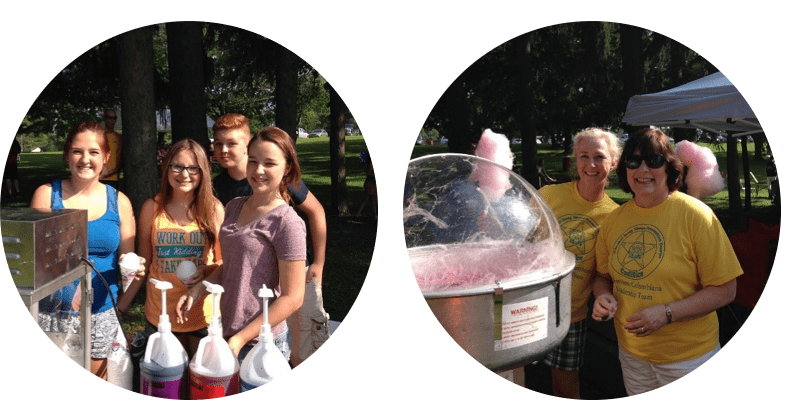
“Columbiana County is located in the northeastern portion of Ohio and is a designated county in the Appalachian Region,” said The Adapt Coalition Program Supervisor Brenda Foor. “Columbiana County shares some of the physical, demographic and social characteristics of Appalachia, including low median income, low educational attainment and a high poverty rate. The county is primarily rural with small communities scattered throughout its 532 square miles. The county has an abundance of active civic and community service organizations and an abundance of faith-based organizations and churches.”
“The 2019 Robert Wood Johnson Health Ranking Report indicates that 24% of Columbiana County youth live in poverty, compared to 20% statewide,” said Foor. “59% are eligible for free lunches compared to 39% statewide. The median household income is $43,100 compared to $54,100 statewide. Economic conditions in Columbiana County have been generally depressed for the past three decades. The rates of unemployment, underemployment, and poverty continue to be higher than the average for the state of Ohio.”
“Appalachian values and world view strongly influence the community,” said Foor. “These values include a strong commitment to family. Connection to community is more highly valued than individual fulfillment or achievement. There is a general suspicion of outsiders and experts, and a preference for local control. Belief that ‘fate,’ rather than individual action or initiative, dictates life outcomes, is prevalent. The culture endorses the medicinal use of alcohol. The county’s borders with Pennsylvania and West Virginia have made it vulnerable to out-of-area drug dealers who can move easily back and forth among these state borders to avoid detection. Marijuana is the most widely used illegal drug. The large amount of farmland makes growing marijuana for personal use and for sale relatively easy.”
“The county is rich in civic organizations and faith communities,” said Foor. “Most locales, even very small ones, have their own police departments and school districts, which also yields community cohesion. Data collected by the coalition reflects that many residents are very concerned about underage drinking and drug use.”
“The ADAPT Coalition was formed in 2008 and received funding from the Drug-Free Communities Support Program in 2010 for 5 years and again in 2015 for 5 years,” said Foor. “The coalition has grown in membership to 250 active members, 150 Youth Coalition members and 7 Leadership Teams. In 2016 the ADAPT Coalition was the 2nd coalition in the State of Ohio to be awarded the Ohio Coalition of Excellence Award.”
“In 2018, the coalition conducted key informant interviews of 13 ADAPT Coalition members,” said Foor. “They indicated that the biggest challenges the coalition faces in achieving its goals include funding, lack of parental involvement, parental drug use, normalization of alcohol and marijuana use and lack of resources available. Members also identified some of the biggest issues youth face today, including peer pressure, social media, negative parental influence, lack of family stability and engagement, parental drug misuse, and poverty.”
“Another unique challenge of the ADAPT Coalition is the potential drivers of substance misuse among Columbiana County youth,” said Foor. “Concerning results from trends identified by surveys involved the mental health of local youth. The percent of students feeling sad or depressed most of the time and/or having attempted suicide was up from 27% in 2011 to 33% in 2018. The percent of students reporting they felt sad or depressed most or all the time in the last month increased from 20% in 2011 to 26% in 2018.”
“The ADAPT Coalition has developed seven Community Leadership Teams, consisting of people who are concerned about underage drinking and drug use in their communities and are willing to work with the coalition to address these problems,” said Foor. “Team members are educated on the position the coalition takes on reducing underage drinking and drug use, as well as the root causes and local conditions that support underage drinking and drug use in Columbiana County. They serve as community educators for their local villages/towns/cities/neighborhoods and collect information on affordable and accessible activities for youth and families in their community. They also work with the coalition to implement campaigns to reduce underage drinking and drug use in their community. The ADAPT Coalition gives each team some funding to implement a pro-social event in their community. Through the pro-social events, Leadership Teams have reached approximately 18,000 community members in Columbiana County.”
“To reduce underage drinking and substance misuse in the county, the coalition focused on strengthening the seven leadership teams,” said Foor. “The team members determine the best pro-social event for the culture of their community, plan and implement the pro-social event, assist the coalition in distributing educational campaign material regarding substance misuse, collect data in the community and represent the ADAPT Coalition at community events by setting up and manning informational tables.”
“Networking is very important,” said Foor. “Addressing the unique socioeconomic and cultural needs of the various communities in our county through data collection, collaboration, and attending CADCA trainings to help with the formation, mission and action plan of the coalition has been integral to our success. It is very important to build and strengthen community partnership/collaboration. Coalitions are only as successful as the passion and participation of the community.”


